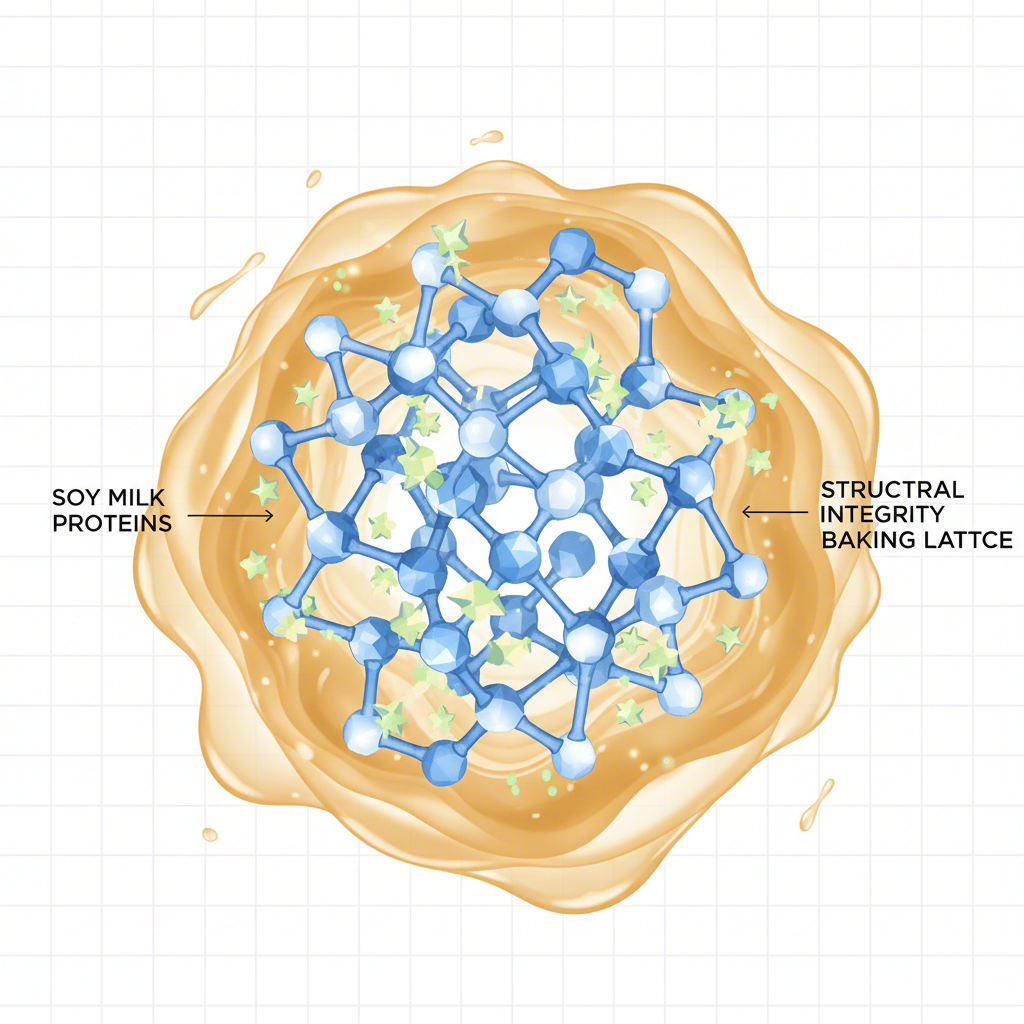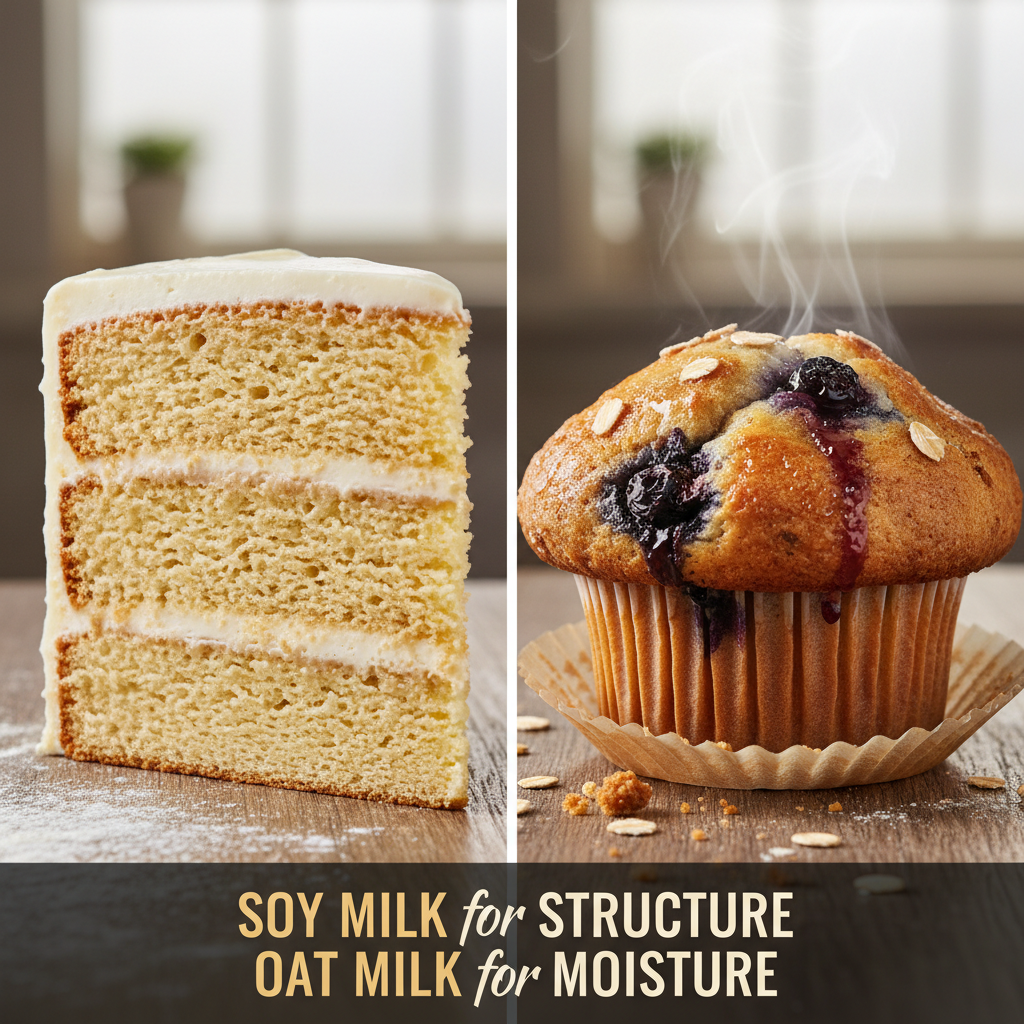TL;DR
When comparing soy milk vs. oat milk for baking, the best choice depends entirely on your recipe’s goal. Soy milk is the top performer for baked goods that need a strong structure, like cakes and yeast breads, because its high protein content closely mimics dairy milk. Oat milk, however, is an excellent choice when you want to add moisture and a creamy, tender texture, making it perfect for muffins, scones, and quick breads.
The Protein Powerhouse: Why Soy Milk Excels in Baking Structure
For bakers seeking dairy-free results that closely replicate those from cow’s milk, soy milk is the undisputed champion. The reason for its superior performance lies in a single, crucial component: protein. This isn’t just a baker’s opinion; the science behind it explains why soy milk creates such stable and well-structured baked goods. Its ability to mimic dairy milk’s effects on texture, rise, and browning makes it a reliable go-to for a wide range of recipes.
Dairy milk contains about 8 grams of protein per cup, which plays a vital role in creating the framework of cakes, breads, and other treats. According to baking experts at Food Network, soy milk comes incredibly close with 7 grams of protein per cup. This high protein content is what gives batters and doughs the strength they need to trap air and rise properly, resulting in a light, fluffy crumb. In contrast, many other non-dairy milks, like almond milk, contain only about 1 gram of protein, which can lead to a less stable structure.
This protein is also essential for browning. The Maillard reaction, a chemical process between amino acids (from protein) and reducing sugars, is responsible for the appealing golden-brown crust on everything from bread to cookies. Because soy milk has ample protein, it facilitates this reaction beautifully, giving your baked goods a rich color that other alternatives might not achieve. A test by King Arthur Baking found that yeast bread made with soy milk had a nearly identical rise, texture, and color to a loaf made with whole milk.
For the best results, always opt for unsweetened, unflavored soy milk to avoid adding unwanted sweetness or vanilla notes to your recipe. It can be used as a 1:1 replacement for dairy milk in most applications, especially where structure is key. Think of layer cakes that need to hold their shape, custard pies that must set firmly, and yeast breads that require a strong gluten network. While some people notice a subtle ‘beany’ flavor, it is typically undetectable once baked with other ingredients.
Pros
- High protein content provides excellent structure and rise.
- Promotes beautiful browning through the Maillard reaction.
- Performs almost identically to dairy milk in many recipes.
- Versatile for cakes, breads, and even custards.
Cons
- Can sometimes have a slight ‘beany’ aftertaste.
- Not suitable for individuals with soy allergies.
The Creamy Contender: Oat Milk’s Role in Moisture and Texture
While soy milk wins on structure, oat milk has carved out its own essential role in the dairy-free baker’s pantry, celebrated for its creamy consistency and ability to impart superior moisture. It shouldn’t be seen as a mere runner-up but as a specialized ingredient that excels in recipes where a tender, moist crumb is the ultimate goal. Its unique properties come from its composition, which is distinctly different from protein-rich soy.
The signature creaminess of oat milk is due to its higher carbohydrate and soluble fiber content, particularly beta-glucans. As explained by dietitians at The Geriatric Dietitian, these components help retain moisture exceptionally well, which translates directly into softer, more tender baked goods. This makes oat milk an ideal choice for items that can sometimes turn out dry, like muffins, scones, and quick breads. Its flavor is another advantage; it’s often described as mild and slightly sweet, allowing the other ingredients in your recipe to shine without any competing aftertaste.
However, the very thing that makes oat milk great—its lower protein and higher carb content—can also be a drawback in certain situations. In recipes that rely on protein for a strong structure, like some breads, oat milk can sometimes produce a gummy or slightly slimy texture, a warning noted by testers at Allrecipes. To counteract this, it’s often recommended to use a ‘full-fat’ version of oat milk, which provides a richer consistency and helps prevent batters from becoming too thin.
The key to successfully baking with oat milk is to play to its strengths. When your primary goal is a moist, tender result rather than a high, airy rise, oat milk is the perfect substitute. It performs wonderfully as a 1:1 replacement for dairy milk in a variety of recipes where its creamy texture is a welcome addition.
Best For:
- Muffins and Quick Breads: Creates a wonderfully moist and tender crumb.
- Scones: Helps achieve a soft interior that isn’t dry.
- Pancakes and Waffles: Adds a creamy richness to the batter.
- Delicately Flavored Cakes: Its neutral taste won’t overpower other ingredients.

Head-to-Head Bake-Off: A Recipe-Specific Comparison
Choosing between soy and oat milk isn’t about which is universally ‘better,’ but which is better for the specific item you’re baking. The fundamental trade-off is clear: soy milk provides structure, while oat milk delivers moisture. Understanding how this plays out in different recipes is the key to mastering dairy-free baking and achieving the perfect texture every time.
The ‘best’ choice is entirely dependent on the desired outcome for your baked good. A delicate layer cake requires the structural integrity that soy milk’s protein provides to prevent it from collapsing. In contrast, a batch of breakfast muffins benefits more from the moisture-retaining properties of oat milk to ensure a soft, tender bite. This decision-making process empowers you to tailor your ingredients to the recipe’s specific needs, ensuring delicious and consistent results.
To make the choice easier, here is a direct comparison of how each milk performs in common baking scenarios.
| Recipe Type | Soy Milk Performance | Oat Milk Performance | Winner/Recommendation |
|---|---|---|---|
| Cakes (Layer, Bundt) | Excellent. Provides a strong, stable crumb and promotes even browning. The structure is very similar to cakes made with dairy milk. | Good. Produces a very moist cake, but the crumb may be slightly denser and less airy due to lower protein. | Soy Milk for structure and a classic cake texture. |
| Yeast Breads | Excellent. The high protein content supports gluten development, leading to a strong structure and a good rise. Loaves slice cleanly. | Fair. Can sometimes result in a gummy texture and a less stable structure. The loaf may be more prone to crumbling. | Soy Milk for a reliable, well-structured loaf. |
| Cookies | Very good. Contributes to a nice chew and good browning. The effect is often subtle as cookies contain less liquid. | Very good. Adds a subtle creaminess and moisture. The difference between the two is minimal in most cookie recipes. | Tie. Both work well; choose based on flavor preference. |
| Muffins & Quick Breads | Good. Produces a reliable, well-structured muffin, but the texture can be slightly less tender than with oat milk. | Excellent. Creates an exceptionally moist, soft, and tender crumb. This is where oat milk truly shines. | Oat Milk for the ultimate moist and tender result. |
After reviewing the direct comparisons, a few rules of thumb emerge. When your recipe needs to stand tall, hold its shape, or develop a sturdy crust—as with layer cakes and yeast breads—reach for soy milk. Its protein content is invaluable for creating that essential structure. On the other hand, when the goal is a soft, moist, and tender texture—as in muffins, pancakes, and scones—oat milk is the superior choice. By matching the milk to the mission, you can confidently substitute dairy in virtually any recipe.
Beyond the Batter: Nutritional and Flavor Profile Showdown
While baking performance is the primary concern for many, the nutritional and flavor differences between soy and oat milk can also influence your choice. These factors can affect not only the health profile of your final product but also its taste. Both milks have distinct characteristics that are worth considering before you start mixing your batter.
From a flavor perspective, the two are quite different. Soy milk is known for having a slightly nutty or ‘beany’ taste. While this is often masked by stronger flavors like chocolate or spices, it could be noticeable in more delicate bakes like a simple vanilla cake. Oat milk, conversely, has a mild, slightly sweet flavor that is much more neutral, making it an excellent option for recipes where you don’t want the milk to impart any taste of its own. In fact, oat milk’s natural sweetness may even allow you to slightly reduce the added sugar in some recipes.
Nutritionally, they also offer different benefits. Soy milk is a clear winner in the protein department, making it a more nutritionally dense option that contributes to satiety. Oat milk is typically higher in calories and carbohydrates but also contains beneficial fiber. For those looking to manage their diet or source ingredients with maximum control, options abound. If you’re interested in making fresh, additive-free plant milks at home, Soy Milk Quick offers a comprehensive guide to plant milk makers that can help you find the perfect machine for your needs.
Here is a simplified nutritional comparison based on typical unsweetened versions:
| Nutrient (per 1 cup) | Soy Milk | Oat Milk |
|---|---|---|
| Calories | ~80-90 kcal | ~120 kcal |
| Protein | ~7 g | ~3 g |
| Carbohydrates | ~4 g | ~16 g |
| Fat | ~4 g | ~5 g |
Ultimately, the choice extends beyond simple chemistry in the oven. Consider the final flavor you want to achieve and any nutritional goals you may have. For a protein boost or in a recipe with bold flavors, soy milk is an excellent choice. For a neutral taste in a delicate dessert or for a fiber addition, oat milk is a fantastic alternative.

Frequently Asked Questions
1. Is oat milk or soy milk better for baking?
Neither is universally ‘better,’ as the best choice depends on the recipe. Soy milk is superior for baking projects that require structure, such as cakes and breads, because its high protein content (around 7 grams per cup) mimics dairy milk, leading to a stable crumb and good browning. Oat milk, on the other hand, is ideal for recipes where moisture and a tender texture are the priority, like muffins and scones, due to its creamy consistency and higher carbohydrate content.
